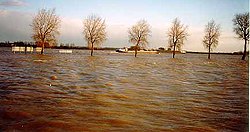|
|
|
Holland is a very unusual country, because a lot of the land is actually below sea level. More than a quarter of the land, in fact, and over half the people in the country live there!
|
|
For two thousand years, huge earth walls, called dykes or polders, have been built to hold back the sea and let the people reclaim land to live on and to farm. Prince Alexander Polder lies 7 meters below sea level, and is the lowest land in all Europe! The word dyke means the earth wall, and polder means the land that is reclaimed from the sea. Here you can see a road running along one of the dykes, and how high the sea level is to the left. |
|
Once dykes are built, canals and pumps are used to drain the land and to keep it dry. From the 1200s, windmills had been used to pump excess water off the fertile soil; today most of the windmills have been replaced with electrical and diesel-driven pumps. Of course if there is a huge storm, or a lot of rain, there can easily be floods. Flooding is a big problem in the Netherlands, because all the land is so low. Up to now the Dutch have responded by building even higher dykes. But they have had some narrow escapes. |
|
In 1995, 250,000 people had to leave their homes when rivers almost burst their banks. Dutch officials are worried that it gets dangerous building the dykes higher and higher, because it makes it even more dangerous when they break. With global warming, what will happen if the sea rises, even by a few centimetres?
Even the highest part of this country is only as high as a little low hill in New Zealand.

